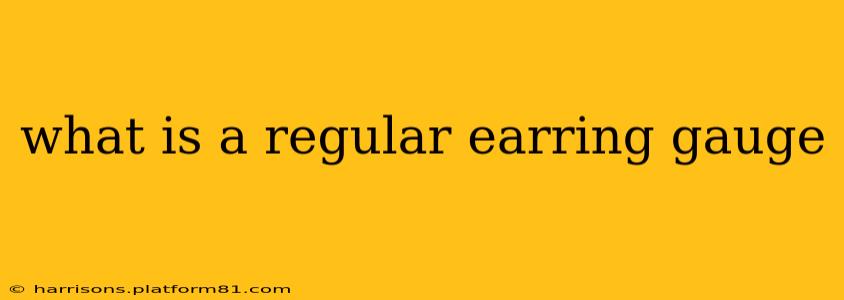Choosing the right earrings often involves understanding earring gauges, a measurement that determines the thickness of the post. While there isn't one single "regular" earring gauge, as preferences vary widely, understanding the common gauges and their uses helps you navigate the world of ear piercings and jewelry. This guide will break down the most frequently used gauges, helping you find the perfect fit for your ears.
What Does Earring Gauge Mean?
Earring gauge refers to the diameter of the post, expressed as a fraction of an inch. The lower the number, the thicker the post. This is counterintuitive, as many people initially assume a higher number means a thicker post. For example, a 20 gauge is thinner than a 16 gauge. This system stems from the wire gauge system used in other industries, where smaller numbers represent thicker wires.
Common Earring Gauges and Their Uses
Here's a breakdown of some of the most common earring gauges you'll encounter:
-
20 Gauge (0.8mm): This is a very popular gauge for initial ear piercings, particularly for lobe piercings. Its thinness makes it less traumatic for the piercing process and generally less noticeable. It's a great starting point for many.
-
18 Gauge (1.0mm): Slightly thicker than 20 gauge, this is still a common choice for initial lobe piercings and is suitable for a wider variety of earrings. It offers more durability than 20 gauge.
-
16 Gauge (1.2mm): This gauge is frequently used for lobe piercings and can comfortably accommodate a broader range of earrings. It's a solid choice for those who want slightly more substantial jewelry.
-
14 Gauge (1.6mm): Thicker still, this gauge is often chosen for those who have stretched their earlobes or for cartilage piercings that need a more substantial piece of jewelry for support and stability.
-
12 Gauge (2.0mm): This and larger gauges are commonly associated with stretched piercings, where the piercing has been gradually enlarged over time. It's significantly thicker than the gauges used for initial piercings.
What Gauge is Best for My Piercing?
The best gauge for your piercing depends on several factors:
- Type of piercing: Lobe piercings generally accommodate smaller gauges (20-16 gauge), while cartilage piercings often require thicker gauges (14 gauge and above) for stability.
- Healing stage: Always start with a smaller gauge for your initial piercing to minimize trauma and ensure proper healing. You can always consider changing to a larger gauge after the piercing has fully healed.
- Personal preference: Ultimately, the gauge you choose is a matter of personal preference. Consider the style and weight of earrings you plan to wear.
What if My Piercing is Too Big or Too Small?
- Too big: If your piercing is too large and your jewelry is loose, it's crucial to consult a professional piercer. They can help you select the appropriate jewelry to avoid infection or damage.
- Too small: If your piercing is too small and your earrings won't fit, don't attempt to force them. Visit your piercer; they can help determine the appropriate gauge and guide you in the process of safe jewelry changes.
How to Measure Earring Gauge?
While you can use tools to precisely measure the diameter, for most people it's sufficient to know the gauge numbers and choose accordingly when shopping for earrings. The gauge size will generally be marked on the earring packaging.
Remember, always consult a professional piercer for any questions or concerns about your piercing. They are the best resource for advice on gauge size, appropriate jewelry, and safe piercing practices.
